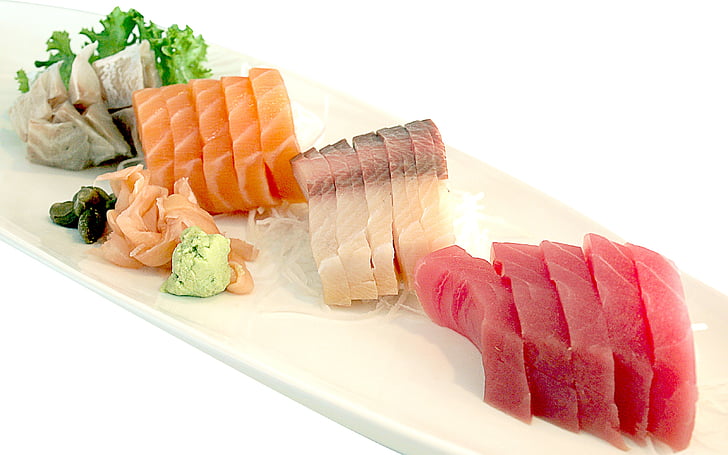Sashimi and Nigiri are two of the most iconic dishes in Japanese cuisine, often leading to confusion when discussing sushi. Despite their similarities, Nigiri and Sashimi are distinct and one might not even qualify as sushi. It's important to appreciate what sets each apart.
In this guide, you'll discover the key differences between Nigiri and Sashimi. You'll also dive into Maki Sushi and explore how it contrasts with Nigiri.
What is Nigiri?

Nigiri represents one of the most authentic and traditional forms of Japanese sushi. It consists of a small mound of vinegared rice also known as sushi rice or sticky rice topped with a slice of raw fish. This sushi type offers a delightful blend of sweet, salty, and savory flavors.
Typically, Nigiri features raw fish such as salmon, tuna, or mackerel, but it can also include cooked shrimp or grilled. Sushi chefs often enhance the flavor by adding sweet soy sauce or wasabi between the fish and rice. Nigiri remains a highly popular choice among sushi enthusiasts.
What is Sashimi?

Sashimi is a traditional Japanese dish that showcases thinly sliced raw fish or seafood, served without rice. Known for its simplicity and purity, sashimi allows the natural flavors of the fresh fish. Common types of sashimi include tuna, salmon, mackerel, and octopus, though a wide variety of seafood can be used.
Sashimi is typically served with garnishes such as shredded daikon radish, shiso leaves, and a dipping sauce like soy sauce, often accompanied by a dab of wasabi. It is considered a delicacy and is highly regarded for its clean, fresh taste and exquisite presentation.
What is the difference between Nigiri and Sashimi?
1. Definition:
- Nigiri: A type of sushi consisting of a small mound of vinegared rice topped with a slice of raw fish or seafood.
- Sashimi: Thin slices of raw fish or seafood generally served without rice.
2. Ingredients:
- Nigiri: Made with vinegared rice (sushi rice) and a topping, usually raw fish.
- Sashimi: Consists only of raw fish or seafood, without any rice.
3. Preparation:
- Nigiri: The sushi chef forms a small ball of rice by hand, then places a slice of fish on top. Sometimes, a small amount of wasabi or sweet soy sauce is added between the fish and rice.
- Sashimi: The fish or seafood is carefully sliced into thin pieces and served with garnishes like shredded daikon radish and shiso leaves.
4. Taste:
- Nigiri: Combines the sweetness and tanginess of vinegared rice with the delicate flavors of the fish. Additional sauces or wasabi can enhance the taste.
- Sashimi: Highlights the pure, natural flavors of the raw fish or seafood, often enjoyed with soy sauce and wasabi.
5. Presentation:
- Nigiri: Typically presented in pairs on a platter, with the fish neatly placed over the rice.
- Sashimi: Artfully arranged on a plate, often accompanied by garnishes and dipping sauces.
6. Popularity:
- Nigiri: Very popular and widely recognized as a classic form of sushi.
- Sashimi: Highly regarded for its simplicity and purity, often considered a delicacy.
7. Variations:
- Nigiri: Includes variations such as shrimp nigiri (cooked shrimp) and eel nigiri (grilled eel).
- Sashimi: Can be made from various types of fish and seafood, such as tuna, salmon, mackerel, and octopus.
Why nigiri cheaper than sashimi?
Nigiri is often cheaper than sashimi because it includes vinegar-ed rice, which adds bulk and reduces the amount of fish needed per serving. Sashimi, on the other hand, uses larger portions of premium fish and requires precise cuts, making it more expensive. Additionally, the higher quality standards for sashimi-grade fish contribute to its higher cost.
Which is the best knife for slicing nigiri and sashimi?
1. Suraisu Master Chef - Kiritsuke Chef Knife - 8 Inch

The Suraisu Master Chef Korouchi Knife is an exceptional choice for preparing Nigiri and Sashimi due to its versatile Kiritsuke blade design and premium construction. The 37-layer Japanese Damascus steel with an AUS10 core ensures excellent sharpness and durability, essential for slicing delicate fish with precision. The 15-degree per side edge angle and V-taper grinding provide an exceptionally sharp edge, making it ideal for clean, smooth cuts required for Nigiri and Sashimi. Additionally, the deep sea abalone shell handle offers a comfortable grip and enhances control, ensuring that each slice of fish is executed perfectly. This knife's combination of traditional craftsmanship and modern technology makes it a top choice for sushi enthusiasts.

